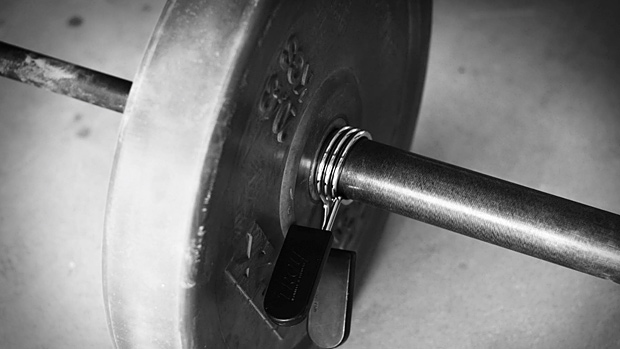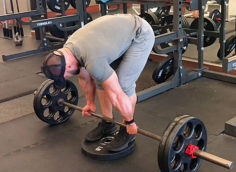I'm sure most of you perform some type of stretching already, but how many consider it an essential part of your training?
Many lifters, especially the bullet-proof 20-somethings, associate stretching with skinny-fat cardio junkies or the patchouli-scented yoga scene, limiting it to the occasional biceps stretch in front of the mirror after a grueling set of cable concentration curls.
Fortunately, the pendulum has started to swing back towards a more well-rounded approach, as more trainees realize that regular stretching can lead to bigger benches, stronger squats, and bulletproof shoulders.
The concept of being "muscle-bound" is a complete crock. If you've ever seen footage of a totally dehydrated and carb-depleted Flex Wheeler hit the splits on stage, you know how flexible someone can be while still sporting copious amounts of muscle. Similarly, Tom Platz, the guy whose quads were bigger than most people's waist, could squat 500-pounds right to the floor with ease.
And those two genetic freaks are not the only examples. Olympic weight lifters are routinely the most flexible athletes in sports, and many elite powerlifters aren't far behind.
If you're still not convinced, get under the bar and perform a few femur-parallel squats – you'll see how important high levels of flexibility through the hips, hamstrings, and ankles can be.
A muscle has to both contract and stretch to see any type of realistic gains in strength. By having a muscle go through a larger range of motion while under tension, it produces a greater amount of strain to the tissues, resulting in greater gains from a single training session.
The increased requirement of the muscles to use the full range of each sarcomere in series means that there'll be more contractile protein cross-links used. This will increase the hormonal response and create a more anabolic environment than performing a less than full range of motion.
Having joints move through their own biomechanically optimal ROM also limits the stress on other areas of the body that would have to compensate for the limitation, such as the knees and low back compensating for hip stiffness.
Since there's so many things that a good pre-game stretch can do, this article will present a simple, quick, and easy pre-workout flexibility booster that will have you moving better and lifting heavier, without looking like some dork who just stumbled out from a downward dog.
One of the easiest ways to increase the flexibility of specific areas of the body is through foam rolling, or self-myofascial release. I'm sure most have tried these pool noodle look-alikes at one time, likely comparing the experience to something similar to passing a kidney stone. The discomfort is a necessity to make the muscle stretch properly.
Rolling gives the muscle a chance to have a mini-massage, which will decrease the tissue density and allow it to "flow" better than if it wasn't rolled out. Strength coach extraordinaire Mike Boyle likes to use the analogy of untying the knot in the muscle before you try to pull on it with static stretching.
By rolling a muscle, you can reduce fascial restrictions known in the manual therapy world as adhesions, which act like a sort of super-glue that binds muscle fibers together when they have some sort of injury or excess stress they're not used to. No movement means no stretch, which means no contraction, and your lifts wind up looking like something that most of my female clients could best.
A great example of this was when I had a student in a continuing education class say that he had chronically tight hamstrings. I asked him to do a forward bend and try to touch his toes, and he proceeded to make it to roughly the top of his knees. I then had him use a small lacrosse ball to roll through the plantar fascia on the bottom of his feet, which he said felt like ripping the skin off his feet with each roll. After a few passes, I had him try to touch his toes again and this time he went hands-to-the-floor, with straight knees.
So by not even looking at his hips or hamstrings, we were able to dramatically increase his range of motion through reducing fascial restrictions in distant parts of the body that were causing some dysfunction.
Here's a good series to do for the lower body, starting at the feet and moving through the posterior hips. Focus on areas that are more tender and spend some extra time there, pretty much until there's no more pain.
Rolling should be done slowly and methodically, like you're driving over a speed bump in a Lamborghini. Speeding through will simply rip the undercarriage off, or in your case, make your tissues feel that way.
After you're finished rolling out whatever you're planning to use that day (in this example, legs), it's time to create some active range of motion. Using an active versus passive stretch before a workout allows you to gradually increase the working temperature of the muscles and joints, and works on mechanically pumping fluid through your muscles, joints, cardiovascular system, and the often-forgotten lymphatic system, which doesn't pump fluid as easily when there's no muscle contraction to propel it through your body as in static stretching.
A basic active warm-up would be broken into three phases:
- Joint-specific
- Movement-specific
- Pattern-Specific
Joint-Specific
This looks at specific range of motion around the major joints, such as the ankle, knee and hip complex. The goal is to stretch the joints through the full range of motion in a pulsating method, similar to old-school ballistic stretching.
Now before everyone balks at the endorsement of ballistic stretching, be aware that speed is a major factor in stretching. Pulsating stretching is done using a controlled speed, much the same way you'd perform a bench press or barbell squat, while ballistic stretching is done for maximal speed to overcome the Golgi tendon organs reflexive contraction response.
In short, we're going to play it cool and move slow and controlled.
Some simple guidelines to joint stretching through the lower body:
- The ankle will always need more dorsiflexion
- The knee will always need more flexion
- The hip will always need more flexion, extension, internal/external rotation, and abduction
- It's almost impossible to get too much mobility from these joints in these directions
Each stretch listed below should be performed like an exercise, for a series of 10-15 reps, or pulses in this context. The goal is to go to full range of motion without feeling pain or recruiting other joints to perform the work.
Movement-Specific
This stretching involves performing variations of the basic movements like squats, lunges, rotations, and front bends, to warm up, or "groove the pattern," as Dr. Stuart McGill puts it. Each of these movements should have the goal of maximal range of motion without falling over or dislocating your sphincter.
Since these movements will work on variations of squats, lunges, and one-foot balancing exercises, and focus on common limitations of the movements, they may seem difficult to do properly if you're somewhat tight at the beginning of the workout. Work on trying to increase range of motion progressively through each rep, and you should feel a big difference between when you start the set and when you finish.
Pattern-Specific Movement
This preparation will include the specific exercises you'll be performing, such as back squats, lunges, etc. Each movement should start with minimal weight to go through the full range of motion, regardless of whether you're planning to use full range of motion in the working set or not. The first set uses essentially no weight, followed by a second warm-up set with roughly half the working-set weight.
Each of the movements given should be performed for one set each, two if the area is severely restricted. By moving fluidly from one movement to the next, this warm-up series should allow the individual to be fully warmed up and actively mobilized within 5-10 minutes. As a bonus, it often helps dramatically increase the work capacity of the workout.
During the working sets of your workout, there's absolutely no reason to not static stretch specific muscles or joints that may feel engorged from the workout or somewhat tender from the intensity of you pissing excellence all over the gym floor.
The body of research that has shown that static stretching can produce a marked depression in force and power production in short-term response to static stretching typically used stretching interventions of 30 seconds or more, for multiple sets. Most people don't do 30 second holds for 5 sets in between their working sets, so this would seem excessive. After all, the goal of these studies was to try to get a response that would hold up in a statistical analysis for significance.
However, there's never been a research study that has shown a decrease in performance from going throughsingle sets of 10 seconds or less. I'd rather a client perform a 10 second stretch during a rest period between working sets to ensure the muscle is still pliable and blood is not pooling in the tissue than to have them simply sit on their asses and do nothing. So go ahead and static stretch in between sets, as long as the stretch is only held for a short duration.
So now you have a game plan to assault flexibility and actually look like you know what you're doing. You'll probably notice some extra looks of admiration from the ladies and book-smart trainers, even the odd big guy who appreciates flexibility as much as you do. As for that weird guy in the headband asking you, "Hey, does that work your calves?" as his tube socks slide down his rake-thin shins? We're sorry about that.





